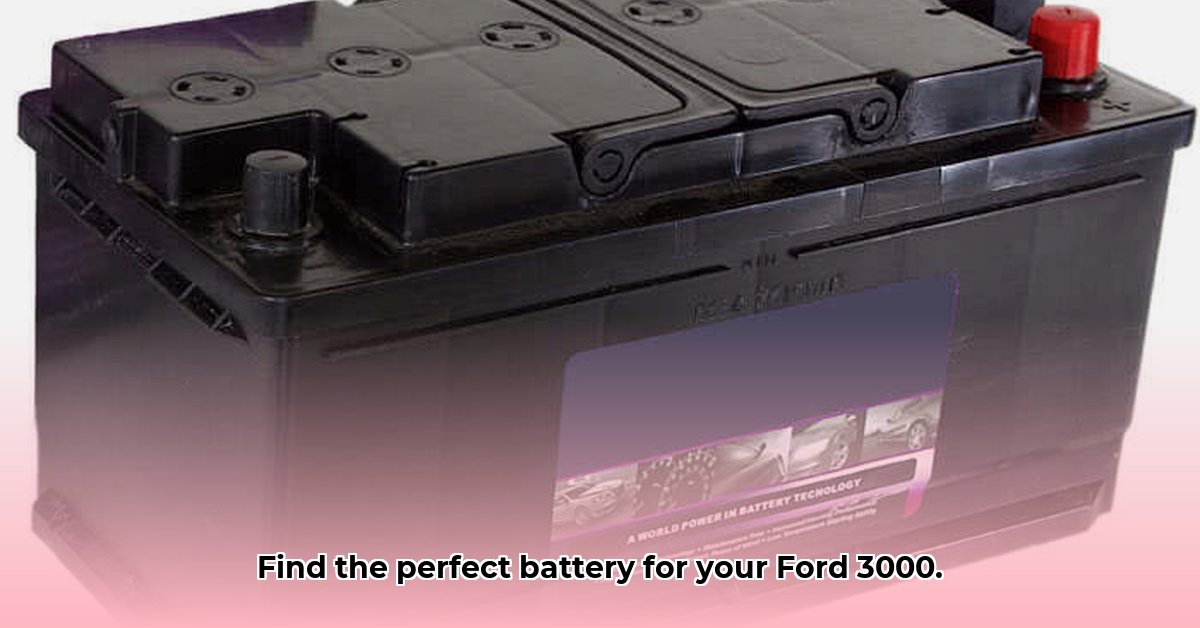
Maintaining peak performance for your Ford 3000 tractor hinges on its battery. This guide provides a step-by-step approach to identifying the correct battery size, performing a replacement, and disposing of the old one responsibly. We'll cover everything from understanding your tractor's power needs to selecting a sustainable battery option. For more detailed Ford 3000 information, check out this helpful resource: Ford 3000 Tractor.
Understanding Your Ford 3000's Power Demands
Before determining the battery size, consider your tractor's workload. Do you regularly tackle heavy-duty tasks like plowing large fields, or is it primarily light-duty usage around the farm? Heavy-duty use necessitates a higher-capacity battery. Climate plays a significant role too; cold weather reduces battery performance, so a larger battery might be necessary in colder regions. This ensures reliable cold-weather starts.
Decoding the Specs: Finding the Right Battery Size and CCA
Precisely identifying your Ford 3000's battery size depends on the year and model. Your owner's manual is the primary source of truth; it specifies the group size (e.g., Group 24, Group 31) and the essential Cold Cranking Amps (CCA). If your manual is unavailable, the battery itself often displays this information. Online forums and agricultural equipment parts websites can also be valuable resources, but verify information across multiple sources to ensure accuracy. Remember that Cold Cranking Amps (CCA) indicate the battery's ability to deliver power at freezing temperatures (0°F/-18°C) for 30 seconds to start your engine.
Beyond Size: Choosing the Right Battery
While knowing the correct size is crucial, other factors influence performance and longevity.
- Cold Cranking Amps (CCA): Higher CCAs are imperative in colder climates for reliable starting.
- Reserve Capacity (RC): This indicates how long (in minutes) the battery can power accessories at 25 amps. A higher RC is beneficial for accessories like headlights.
Battery Type: Flooded lead-acid batteries are common and affordable. However, AGM (Absorbent Glass Mat) and gel cell batteries offer superior vibration resistance, less leakage, and longer lifespan, albeit at a higher cost.
Sustainability: Opt for manufacturers with robust recycling programs and a commitment to responsible production, minimizing your environmental impact. Recycling your old battery is crucial for a sustainable approach.
Step-by-Step Battery Replacement
Replacing your Ford 3000's battery is straightforward. Follow these steps for a safe and efficient replacement:
- Safety First: Disconnect the negative (-) terminal first, then the positive (+). This prevents short circuits.
- Careful Removal: Gently remove the old battery, noting its orientation for easier reinstallation.
- Clean Up: Clean the battery terminals and tray with a wire brush to remove corrosion.
- Secure Installation: Place the new battery securely in the tray.
- Reconnect Terminals: Connect the positive (+) terminal first, then the negative (-).
- Final Check: Start the tractor to confirm the new battery functions correctly.
Comparing Battery Types: A Quick Overview
| Battery Type | Advantages | Disadvantages |
|---|---|---|
| Flooded Lead-Acid | Affordable, widely available | Can leak, needs maintenance, shorter lifespan |
| AGM | Spill-proof, durable, longer lifespan | More expensive |
| Gel Cell | Excellent vibration resistance, long lifespan | Highest price point, less widely available |
Responsible Battery Disposal: Protecting Our Environment
Proper disposal of old batteries is vital. They contain hazardous materials; improper disposal contaminates the environment. Partner with your local recycling center or auto parts store – many offer battery recycling programs – for safe and responsible disposal. This minimizes environmental harm. "Proper disposal of used batteries is essential for environmental protection," states Dr. Emily Carter, Professor of Chemical and Biomolecular Engineering at Princeton University.
Key Takeaways:
- Correct battery size is crucial for optimal tractor performance.
- Responsible battery disposal protects the environment and human health.
- Recycling programs are vital for sustainable battery management.
- Understanding different battery types guides the choice of appropriate disposal methods.
This comprehensive guide empowers you to maintain your Ford 3000 tractor efficiently and responsibly. Remember to always consult your owner's manual for model-specific details.